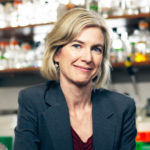
Emmanuelle Charpentier, PhD
“Innovation in the technology field always originates from basic science. Without basic science, without the understanding of the mechanism that bacteria evolved to defend themselves against infections that led to this technology — it’s really where CRISPR comes from.”
Dr. Emmanuelle Charpentier is the Founding, Scientific and Managing Director of the Max Planck Unit for the Science of Pathogens and Honorary Professor at Humboldt University. She is best known for her co-discovery of a molecular tool known as clustered regularly interspaced short palindromic repeats (CRISPR)-Cas9, and was awarded the 2020 Nobel Prize in Chemistry along with her collaborator Dr. Jennifer Doudna for the development of a method for genome editing.
Dr. Charpentier has focused most of her scientific career on the understanding of fundamental mechanisms of diseases with a particular focus on infections caused by Gram-positive bacterial pathogens such as Listeria, staphylococci and streptococci. Her research on the CRISPR-Cas9 adaptive immune system in the human pathogen Streptococcus pyogenes and other bacterial species has laid the foundation for the development of CRISPR-Cas technology, a novel, highly versatile and specific genome editing and engineering technology that is revolutionizing life sciences research. CRISPR-Cas has opened whole new opportunities in biotechnologies and in biomedical gene therapies that are impacting society and humanity.
For her and her team’s contributions to the CRISPR-Cas9 discovery, Dr. Charpentier has received numerous honors, decorations, prizes, awards and honorary doctorate degrees from Europe, Asia and North America. She is an elected member of national and international scientific academies including the Royal Swedish Academy of Sciences, European Academy of Sciences and Arts, and European Molecular Biology Organization (EMBO).
Dr. Charpentier co-founded CRISPR Therapeutics and ERS Genomics with the aim to develop the CRISPR-Cas genome engineering technology for biotechnological and biomedical applications.







